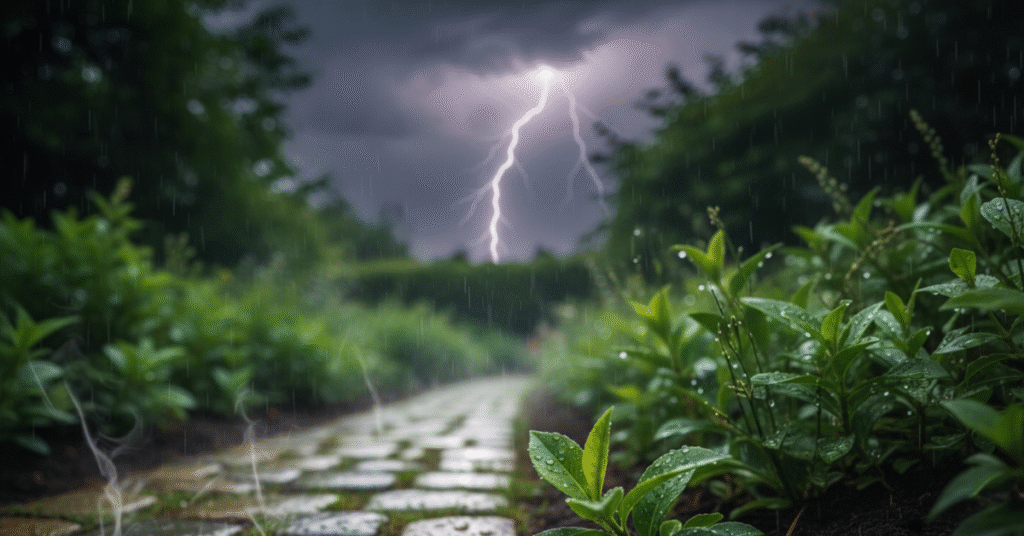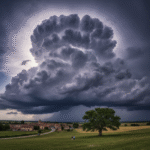I don’t know about you, but for me, there’s nothing quite like that distinct smell after the first drops of a summer rain. It brings a sense of calm and a feeling of freshness that’s hard to describe. For a long time, I never really questioned it; I just enjoyed it. But recently, I found myself asking, why does it smell like rain? As it turns out, the answer is a fascinating mix of science, biology, and chemistry. The smell even has its own special name: petrichor.
Here’s the detailed science behind that wonderful scent.
The Main Ingredients: Geosmin and Petrichor
The scent of rain isn’t just one thing—it’s a cocktail of different compounds. The two main components are geosmin and a substance called petrichor. Let’s break down what they are:
- Geosmin: This is a chemical produced by a type of soil-dwelling bacteria called Actinobacteria. These bacteria thrive in wet, warm soil, and when the soil dries out, they produce tiny spores. The air carries these spores, which is what we often smell. Humans are incredibly sensitive to geosmin; in fact, we can smell it even at a few parts per trillion. This is a key reason why does it smell like rain is such a strong and recognizable scent for us.
- Petrichor: This is an oily yellow substance produced by plants during dry periods. It collects on the surfaces of rocks and soil. The smell of rain science is that this oil combines with the geosmin to create the unique scent we all know.
How the Magic Happens

So, how do these chemicals get from the ground to our noses? It’s all thanks to the raindrops themselves. When a raindrop hits a dry, porous surface (like concrete or soil), it traps tiny air bubbles. Think of what happens when you pour fizzy water into a glass. As the drop soaks into the ground, these air bubbles rise to the surface and burst, releasing tiny particles of geosmin and petrichor into the air. This process, called aerosolization, sends the particles up to us so we can smell them. This is the simple but brilliant explanation for why does it smell like rain. The stronger the rain, the more of these particles are released, making the smell even more powerful.
Our Evolutionary Connection to the Scent
Our strong ability to detect geosmin is not a coincidence. Scientists believe that our ancestors may have relied on this scent as a signal for water. The petrichor meaning and its connection to rain would have been a crucial survival tool. For ancient humans, rain was a sign of life, food, and security. Because of this evolutionary link, the smell of rain has a calming, comforting effect on our brains, reminding us of our deep connection to nature. This is a truly amazing fun fact about stomach acid sorry… about the smell of rain that shows how our senses are tied to our past.
A Scent That Travels Miles
Another fascinating fact is how far the smell can travel. The tiny aerosol particles are carried by the wind and can be smelled long before the rain itself arrives. Have you ever smelled the rain coming and then seen a storm cloud appear on the horizon? That’s not a coincidence. This is a direct answer to why does it smell like rain even when it’s not raining yet! The scent is a traveling signal that a storm is on its way.
The Smell of Freshness: More Than Just Petrichor
While petrichor is the main component, other factors also contribute to that fresh, clean smell. During a thunderstorm, lightning can split oxygen molecules, forming ozone (). Ozone has a sharp, slightly sweet smell, similar to chlorine. When you get a whiff of that sharp, electric scent just before the storm, you’re actually smelling ozone created by the lightning. So, why does it smell like rain has an extra layer of complexity—it’s a combination of nature’s different elements working together.
In conclusion, that wonderful, familiar smell of rain is not just a simple scent but a complex and beautiful combination of biology, physics, and chemistry. It’s the unique blend of a humble bacteria, a plant’s protective oil, and the power of raindrops hitting the ground. The next time you experience it, you’ll not only appreciate the beauty but also understand the science behind it.






